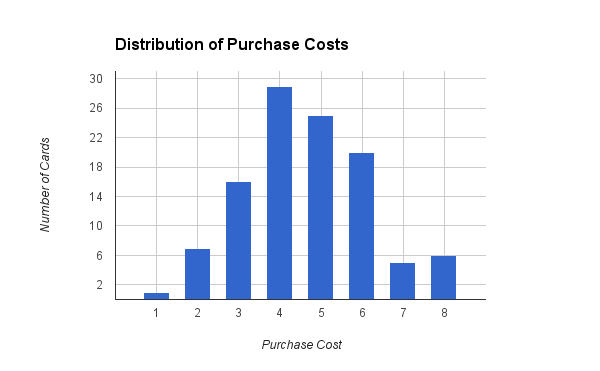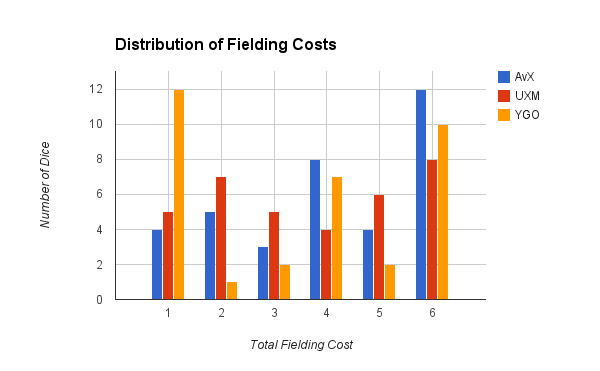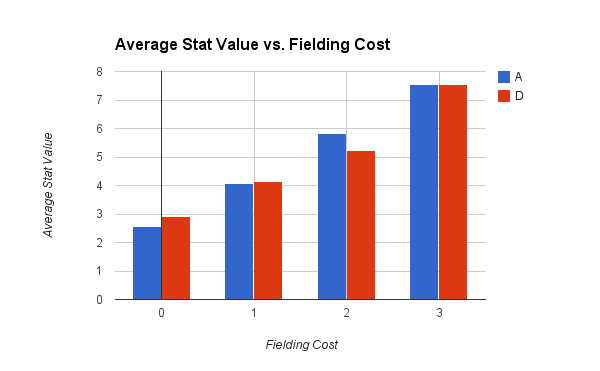 Ahh, a new Dice Masters set. New cards to choose from, new dice to use...and a fresh opportunity to
Ahh, a new Dice Masters set. New cards to choose from, new dice to use...and a fresh opportunity torun some numbers! With UXM providing a marked improvement in the balance of costs, both purchase and fielding, it was always going to be interesting to see where they went from there.
So without further ado...
Purchase Costs: A Larger Bell (Mostly)
Okay, yeah, that's not exactly a bell curve - the end is a little flat, and the peak is a little early, and it's a bit more heavily weighted towards the latter half of the curve. Frankly, though, it's close enough, and it means there isn't that much wackiness a la AvX going on. What is to note is that our family of purchase costs has expanded! In-set cards had previously shown up with costs from 2 to 7, but Yu-Gi-Oh has added a 1 with Canopic Jar, as well as a number of 8s, mostly flavors of the various super-rare 'featured' monsters. So it looks to me like they're upping the ante on early-game speed, while also opening the door for bigger top-end creatures - building on that progression idea that UXM tried to really hammer home.
Most of the 1/2 characters are no-ability quicksummon fodder, like UXM's 2-costs, but a couple - Kuribo: Yugi's Protector and Morphing Jar: All-Seeing Eye - do; neither are super powerful, but they're not bad. This could be chalked down to a level of power creep, but frankly I think it's just trying to get in some variety at the low end. On the flip side, the 8s have abilities of varying usefulness. This maybe isn't the best thing for what would be, by nature, your capstone monster, but they all have stellar stats, which somewhat justifies their high costs.
Average purchase cost this time around is 4.67 (4.69 if you include the non-basic actions), slightly higher than UXM - not really a surprise with those 8s weighing down the back end, and with 5s/6s being a good bit more common than 2s/3s. That said, there are a lot of 4 cost cards this time around, suggesting that they want more variety in the first-turn options without necessarily wanting lots of multibuy/'and then I use the Professor X global' possibilities.
Where it gets interesting is the by-energy type breakdown. Gone are the days where all the types have roughly the same number of dice; in YGO, we have twelve Bolts, twelve Fists, seven Shields, and seven Masks. I'm not entirely sure what to think of this; I imagine it's following theme, and I've no problem with that. That said, it's unfortunate that Shield got so few dice this set; they've always been a bit of the underappreciated flavor, and this feels like it'll worsen that; compound that with the relative strength of Bolts and Fists in past sets, giving them more of an advantage seems a bit much.
On the other hand...the Bolt average cost is a whopping 5.69 this set. While this is spiked by having three of the super-rare characters (who are, as a rule, very expensive to purchase), it still speaks of them getting a lot of big bruisers and not a lot of speed characters...which is exactly what bolt didn't need. Masks ended up slightly more expensive than UXM, at 4.11, with the super-cheap Morphing Jar balanced out by the expensive Dark Wizard and most of the rest being around average. Fists ended up slightly cheaper, at 4.47; Obelisk the Tormentor is balanced out by a number of cheaper characters, and there are relatively few other expensive characters around. And...despite my bellyaching about fewer opportunities from fewer dice, Shield wound up the winner, cost-wise, clocking in at 3.86 - almost a full point lower than UXM - it has only a few 5s, one six, and a lot of 2s and 3s.
The Valley of Fielding Costs
First things first: the average fielding cost in YGO is 3.47, slightly cheaper than UXM but nothing to really talk about a big change one way or the other. When you look at how they're distributed, though...
So yeah, that middling average fielding cost is the result of a giant pile of really cheap characters being canceled out by an almost-as-giant pile of really expensive characters, with a few more middling characters bringing the average up. We've got two TFC values making up almost two-thirds of the set, and three making for something like 85% of it. As the side-by-side comparison shows, we've wound up with an even spikier set than AvX!
That said, this isn't all bad. Like the average - and the values - suggest, despite several TFC values taking a siesta for an expansion, we've still got some balance; we're not drowning in expensive dice like we were in AvX. No, we're actually drowning in super-cheap dice this time, giving us lots of options for our aggro teams...though it's interesting to note that not all the cheap dice are exactly cheap to purchase, like Thousand Year Dragon. Really, I think this is another case of the 'cheap characters to buy expensive' progression getting reinforced - we're getting a lot of breadth in our cheap/early buys, and (as usual) lots of high-end options. So while it looks strange after the relatively balanced UXM setup, I don't think there's anything that wrong with it, except maybe some concern as to how much fielding cost is being used to balance a die.
Outside of that, there's a few things of note. Black Luster Soldier is our first non-TFC 3 character with a nonstandard TFC profile, costing 2 at all levels (or nothing, if you use his Ritual ability). I think overall that's a little more useful than the normal TFC 6 progression, as you always know what it's going to cost you to get him out. Masks have gotten even cheaper than in UXM, clocking in with an average TFC of 2.25; unsurprising given that their roster is all 1s outside of Dark Magician. Shields, however, are the dark horse cheapest type in the set, with a crazy low 2 average TFC - less than half what they had in UXM; again, they have almost all cheap creatures, with only Jinzo (4) and Sangan (2) being over TFC1. Kind of strange to think of Shield as 'the cheap flavor' after being ponderously expensive in the previous two sets. Fists are at 4.09, a little higher than last time - they've got a few heavies like Obelisk and Black Luster Soldier, so it's not a surprise - while Bolt is almost three-fourths of a point up, which doesn't surprise me at all with its multiple Egyptian God heavyweights.
Stats: Creeping Upwards
If you'll remember, UXM was notable for having a more offensive bent to its characters. How did YGO do?
Well, 2 managed to be more offensive than defensive, 1 is almost the same for both scores, and 3 is actually even; I wouldn't say that YGO has offensive-minded dice so much as balanced ones...but it's a high balance point. Comparing to UXM, every fielding cost has better stats, ranging from about a third of a point for 0/1 attack to over a point for level 3 attack. Given the relatively similar purchase costs to UXM, it maybe feels a little like the first signs of power creep, getting more for the same cost, but I like to think they're balancing this out via the abilities. I'd like another point or two on the continuum before I really make any judgments as to where the power vector is headed, and how fast.
Comparing stats to TFC tells us a similar story...once you ignore the values for 2, 3, and 5, because of how few dice each of them has. I mean, seriously - 2 is just Sangan, and 3 has the wildly-stat-imbalanced Goblin Attack Force skewing its numbers all over the place, and 5 has the intensely underwhelming Man-Eater Bug doing the same in a different way.
Looking at the 1s, though, there's a near-half point spike in their stats, and similarly for the TFC 6 characters. 4s are the only anomaly in this trend; while their offense is up over half a point, they've lost nearly a point of defense from UXM; taking a look at the UXM characters, though, we see Bishop, Emma Frost, and Iron Man, all fairly tanky characters, making up three of their four, so perhaps that's just a little bit of a bias from the relatively small sample size. Most of the YGO 4s seem to be mid-to-high-range offense-focused dice (with the exception of Harpy Lady, who is a little underwhelming for a TFC4) explaining its offensive bent, and why its defense ended up lower.
Thanks to sample size shenanigans, it's a little hard to compare the two sets, but looking at the most strongly represented ones - 1 and 6 - it makes me think about how rising stats affect the meta. Again, I'm not sure about power creep - we really need to see how things progress a bit more, and hopefully in a way that doesn't make half the TFC values not really suitable for examining - but that the TFC 1 characters are climbing to 3/3 on average sets off some alarms for me. With that, the number of unblocked 'cheap' characters (what an aggro deck would field) you need to get your knockout goes down, meaning shorter, more 'swingish' games - which not everyone appreciates! That said - and this is outside the realm of numbers, so it doesn't really come out in what I present here - we have been getting a lot more board control and die advantage abilities, so while you need fewer dice to get that knockout, it's also easier to keep them from doing their thing. And that's good! A game with abilities shouldn't be all about the numbers.
Conclusion: Even Math Has Its Limits
So what have we learned from YGO's numbers? Costs seem to be staying about the same when you look at an average, but WizKids is playing with how things bunch up, and expanding our ranges. This speaks to exploring new things while trying to keep a sense of balance. I can't ask for anything more - expanding what we have access to keeps the game fresh and interesting, and I'm all for that.
Stats appear to be going up without any appropriate 'counter', at least in terms of cost...and really, that's the big limit to this sort of analysis - it doesn't have a hard and fast way of quantifying abilities. YGO's abilities tell a story of more board control, which is one way of dealing with the rising stats. I. however, can't tell that story through numbers, unless I were to go ahead and quantify the abilities - and that'd be subjective rather than the cold hard grip of fact the straight numbers provide. But you know what? I'm not worried about that; I'm actually happy, as it means they're getting more complex in how the game is balanced, which, at least in my mind, is a sign for rising fun as we figure out its nuances.
So is this style of analysis useless? I don't think so - it does alert us to wackiness and trends in the set, which is a good thing to keep in mind. It isn't, however, the only thing we should be using - which isn't to say I, or anyone else, has been using it as their sole metric for figuring out what's good or not! It just highlights that, as the game grows, we're going to have to consider other metersticks than numbers on cards/dice. And guess what? We'll be having something to say about that in the upcoming podcast!
Now, to start sharpening my spreadsheets for DADDM...

.png)

.png)
.png)
.png)
Awesome stuff, Evan. Really interesting.
ReplyDeleteI always appreciate your stat-analysis on Dice Masters sets. Really interesting and different look at things. Keep it up.
ReplyDeleteThis Yu-Gi-Oh set is also interesting in the number of Max 1 and Max 2 cards. All of the Starter Set monster cards have a Max die limit of 2. Most of these change to the normal Max 4 except for Dark Magician, Red-Eyes B. Dragon and one version of Blue-Eyes White Dragon. All the Super Rare monsters have a Max die limit of 1.
ReplyDeleteThe Millennium items are also rather interesting, having only 1 Uncommon card each.
In contrast, I've the D&D set has a max 4 on every card in the set. It's kinda neat looking at how hugely different both IPs are.
ReplyDeleteVery interesting article. Although I am not buying everything from Dice Masters (I'm most of Superheroes) there are a lot of interesting cards/dice in Yugi... And I am a very hugh fan of Dungeons and Dragons, so I cant wat to have a Booo in my hands xD. Here, in Spain, there is an opene discussion about the compatibility between all these sets and Marvel/DC ones. I mean... D&D has characters and weapons. How do you use them with a Hulk or a Magneto? xD Carry on with your work on this blog. It's awesome.
ReplyDeleteThe short answer is that you don't. Some things aren't going to mix up well. But it will be interesting to see how the sets turn out.
Delete